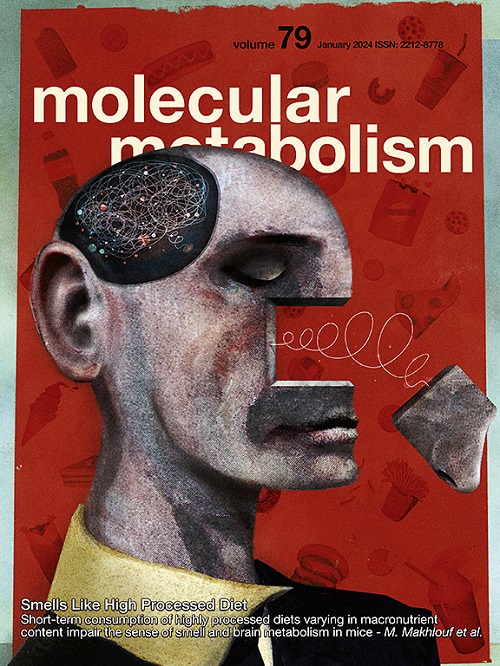Gut microbiota-derived extracellular vesicles exhibit diurnal regulation and activate hepatic gluconeogenesis
IF 6.6
2区 医学
Q1 ENDOCRINOLOGY & METABOLISM
引用次数: 0
Abstract
The circadian clock regulates tissue-specific homeostasis, and its disruption is associated with metabolic disorders. Both host metabolic processes and the gut microbiota exhibit diurnal regulation, and both contribute to the maintenance of glucose homeostasis (Thaiss et al., 2014; Bishehsari et al., 2020; Frazier et al., 2023) [1–3]. However, how the gut microbiota and the circadian rhythm interplay to control host glucose homeostasis is not fully understood. Here, we identified gut microbiota-derived extracellular vesicles (MEV) as a potential peripheral Zeitgeber (time cue) for the hepatic circadian clock, controlling hepatic gluconeogenesis. Host feeding patterns influence the gut microbiota, driving the diurnal production of MEV. Gut MEV levels coincide with the activity of hepatic gluconeogenesis, with overnight fasting associated with increased production of MEV by gut bacteria. MEV directly activates hepatic gluconeogenesis and chronic increase in MEV exposure impairs glucose homeostasis in vivo. Our finding highlights a mechanism by which the gut microbiota has co-evolved with the host to support its glucose needs during periods of energy demands (such as during fasting or starvation). On the contrary, an abnormal increase in MEV production, leading to dysregulated gluconeogenesis, may underlie various glucose-associated disorders, such as type 2 or gestational diabetes. Together, our data reconcile the gut microbiota and circadian rhythm in the control of host glucose homeostasis and metabolic health.
肠道微生物来源的细胞外囊泡表现出昼夜调节并激活肝脏糖异生。
昼夜节律钟调节组织特异性体内平衡,其破坏与代谢紊乱有关。宿主代谢过程和肠道菌群都有昼夜调节,都有助于葡萄糖稳态的维持[1-3]。然而,肠道微生物群和昼夜节律如何相互作用以控制宿主葡萄糖稳态尚不完全清楚。在这里,我们确定了肠道微生物来源的细胞外囊泡(MEV)作为肝脏生物钟的潜在外周授时细胞(时间线索),控制肝脏糖异生。宿主的摄食模式影响肠道菌群,驱动MEV的日产量。肠道MEV水平与肝脏糖异生活动一致,夜间禁食与肠道细菌MEV产量增加有关。MEV直接激活肝脏糖异生,长期增加MEV暴露会损害体内葡萄糖稳态。我们的发现强调了肠道微生物群与宿主共同进化的机制,以支持其在能量需求期间(如禁食或饥饿期间)的葡萄糖需求。相反,MEV产生的异常增加,导致糖异生异常,可能是各种葡萄糖相关疾病的基础,如2型或妊娠糖尿病。总之,我们的数据调和了肠道微生物群和昼夜节律在控制宿主葡萄糖稳态和代谢健康方面的作用。
本文章由计算机程序翻译,如有差异,请以英文原文为准。
求助全文
约1分钟内获得全文
求助全文
来源期刊

Molecular Metabolism
ENDOCRINOLOGY & METABOLISM-
CiteScore
14.50
自引率
2.50%
发文量
219
审稿时长
43 days
期刊介绍:
Molecular Metabolism is a leading journal dedicated to sharing groundbreaking discoveries in the field of energy homeostasis and the underlying factors of metabolic disorders. These disorders include obesity, diabetes, cardiovascular disease, and cancer. Our journal focuses on publishing research driven by hypotheses and conducted to the highest standards, aiming to provide a mechanistic understanding of energy homeostasis-related behavior, physiology, and dysfunction.
We promote interdisciplinary science, covering a broad range of approaches from molecules to humans throughout the lifespan. Our goal is to contribute to transformative research in metabolism, which has the potential to revolutionize the field. By enabling progress in the prognosis, prevention, and ultimately the cure of metabolic disorders and their long-term complications, our journal seeks to better the future of health and well-being.
 求助内容:
求助内容: 应助结果提醒方式:
应助结果提醒方式:


